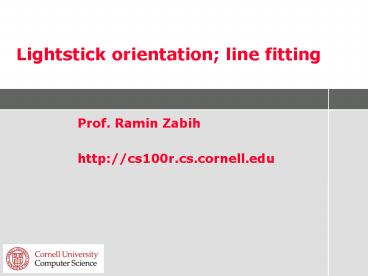Lightstick orientation; line fitting - PowerPoint PPT Presentation
Title:
Lightstick orientation; line fitting
Description:
Assignment 4 out, due next Friday. Quiz 5 will be Thursday ... Cross product leftness ... A less smart test for leftness. A pair of points defines a line y=mx b ... – PowerPoint PPT presentation
Number of Views:22
Avg rating:3.0/5.0
Title: Lightstick orientation; line fitting
1
Lightstick orientation line fitting
- Prof. Ramin Zabih
- http//cs100r.cs.cornell.edu
2
Administrivia
- Assignment 4 out, due next Friday
- Quiz 5 will be Thursday Oct 18
- TA evals for Gurmeet and Devin
- Course midterm eval!
- Dense box algorithm, RDZs way
3
? Mean shift algorithm
- Mean shift centroid minus midpoint
- Within a square
4
Gift-wrapping algorithm
- Convex hull smallest convex polygon containing
the points - Gift-wrapping
- Start at lowest point
- Find new point such that all the other points lie
to the left of the line to it - I.e., the largest angle
- Repeat
Figure c/o Craig Gotsman
5
Computing orientation
- We have a convex shape
- Now what?
- We could fit the polygon with an ellipse
- Then use the major and minor axis
- Major axis would tell us orientation
- Small minor axis is a sanity check
- Ellipse fitting will be a guest lecture on 11/20
6
Polygon major/minor axis
- We can look for the pair of vertices that are the
farthest from each other - Call this the major axis
- Closest pair can be the minor axis
- Or perhaps the closest pair on opposite sides of
the major axis?
7
Cross product leftness
- The area of a triangle is related to the cross
product of the edge vectors - http//geometryalgorithms.com/Archive/algorithm_01
01/
8
A less smart test for leftness
- A pair of points defines a line ymxb
- With a slope m and intercept b
- Think of this as a way to predict a value of y
given a value of x - We call x the independent variable
- Example x date, y DJIA
- If m is positive and finite, what can we say
about the points to the left of the line? - We have to be careful with directionality
- Also non-positive/non-finite cases
9
New topic robot speedometer
- Suppose that our robot can occasionally report
how far it has traveled (mileage) - How can we tell how fast it is going?
- This would be a really easy problem if
- The robot never lied
- I.e., its mileage is always exactly correct
- The robot travels at the same speed
- Unfortunately, the real world is full of lying,
accelerating robots - Were going to figure out how to handle them
10
The ideal robot
11
The real (lying) robot
12
Speedometer approach
- We are (as usual) going to solve a very general
version of this problem - And explore some cool algorithms
- Many of which you will need in future classes
- The velocity of the robot at a given time is the
change in mileage w.r.t. time - For our ideal robot, this is the slope of the
line - The line fits all our data exactly
- In general, if we know mileage as a function of
time, velocity is the derivative - The velocity at any point in time is the slope of
the mileage function
13
Estimating velocity
- So all we need is the mileage function
- We have as input some measurements
- Mileage, at certain times
- A mileage function takes as input something we
have no control over - Input (time) independent variable
- Output (mileage) dependent variable
Independent variable (time)
Dependent variable (mileage)
14
Basic strategy
- Based on the data, find mileage function
- From this, we can compute
- Velocity (1st derivative)
- Acceleration (2nd derivative)
- For a while, we will only think about mileage
functions which are lines - In other words, we assume lying, non-accelerating
robots - Lying, accelerating robots are much harder
15
Models and parameters
- A model predicts a dependent variable from an
independent variable - So, a mileage function is actually a model
- A model also has some internal variables that are
usually called parameters ? - In our line example, parameters are m,b
Parameters (m,b)
Independent variable (time)
Dependent variable (mileage)
16
How to find a mileage function
- We need to find the best mileage function
- I.e., the best model
- I.e., the best line (best m,b)
- Were going to define a function Good(m,b) that
measures how much we like this line, then find
the best one - I.e., the (m,b) that maximizes Good(m,b)
- Such a function Good(m,b) is called a figure of
merit, or an objective function - If you really want to impress your friends, you
can tell them youre doing parameter estimation
17
Figure of merit?
- What makes a line good versus bad?
- This is actually a very subtle question
18
Residual errors
- The difference between what the model predicts
and what we observe is called a residual error
(i.e., a left-over) - Consider the data point (x,y)
- The model m,b predicts (x,mxb)
- The residual is y (mx b)
- Residuals can be easily visualized
- Vertical distance to the line
19
LS fitting and residuals

